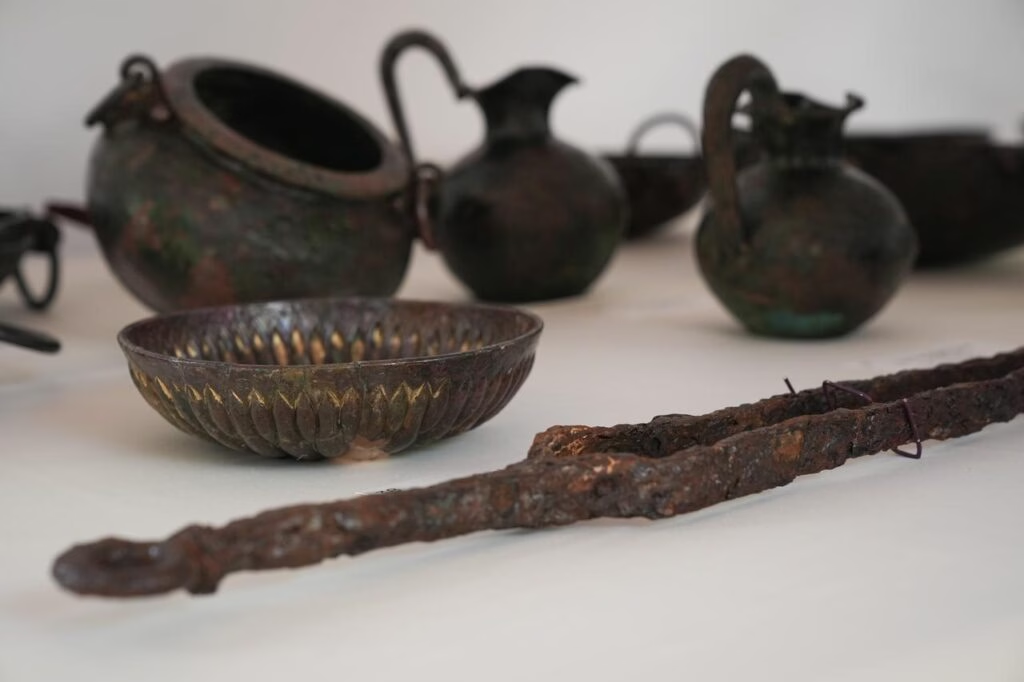A major archaeological discovery in the heart of Anatolia is captivating the global historical community. In the ancient city of Gordion, located near Ankara, Turkish archaeologists have unearthed an extraordinarily well-preserved wooden burial chamber believed to belong to a member of the Phrygian royal dynasty.
Minister of Culture and Tourism, Mehmet Nuri Ersoy, revealed the discovery on-site, emphasizing its significance as one of the most important finds since the legendary Midas Mound was excavated.
“This wooden tomb is one of the largest discoveries in recent decades in Gordion,” Ersoy noted. “Based on the burial goods and location, it likely belonged to the royal family associated with King Midas.”
An Intact Wooden Tomb and Royal Artifacts
Excavations in Tumulus T26—conducted by a team led by Professor Süleyman Yücel Şenyurt—have revealed 88 intricately crafted metal objects, including large bronze cauldrons and iron-nailed vessels mounted along the tomb’s walls. These artifacts reflect a high level of craftsmanship and ceremonial significance.
The tomb is structurally similar to the renowned burial chamber found beneath the Midas Tumulus, a tomb believed to have been built for King Gordios, father of Midas.

Gordion: A Cultural Beacon of the Ancient World
Gordion, now officially listed as a UNESCO World Heritage Site (as of 2023), has long been recognized as the capital of the Phrygian civilization. With continuous settlement dating back to 2500 BCE, the city served as a vital center of politics, craftsmanship, and trade in early Anatolia.
Often compared to cities like Rome and Athens for its influence, Gordion was a nexus for innovations in textiles, architecture, and stone mosaic art.
Legend of the Gordian Knot Rekindled
No account of Gordion is complete without mentioning the famed Gordian Knot—a prophecy-laden puzzle that Alexander the Great famously “solved” by slicing through it with his sword in 334 BCE. The latest excavations hint that the knot’s physical location may have been in the city’s so-called Mosaic Building, where a rare gold-and-ivory sphinx was recently unearthed.
From Excavation to Exhibition: What Comes Next
Nearly half of the discovered artifacts have already been restored and showcased during the Minister’s announcement. The burial chamber and its treasures are scheduled to be displayed to the public at the Gordion Museum by the end of 2025.
Professor Brian Rose from the University of Pennsylvania, who also oversees ongoing digs, emphasized Gordion’s unmatched status in archaeology:
“This city isn’t just ancient—it’s foundational. What we’re learning here reshapes our understanding of East-West cultural transmission.”

A Glimpse into the World of King Midas
While the myth of the “golden touch” is likely symbolic, researchers propose that Phrygian aristocracy may have worn garments dyed with golden pigments like goethite, which could have inspired the legend.
This recent discovery adds another layer of depth to Gordion’s already legendary status, reaffirming it as one of the most important archaeological landscapes of ancient Eurasia.
Cover Image Credit: Public Domain





